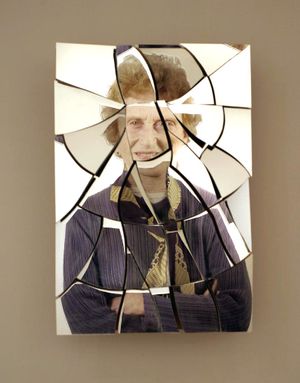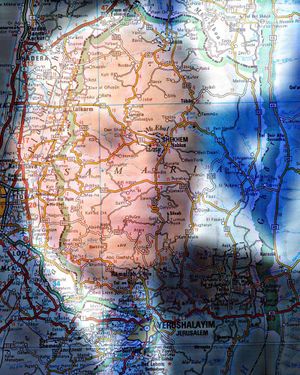Daniel Rozin
![[1]](http://wiki.ubc.ca/images/9/91/Daniel_Rozin_Artist.jpg)
Born: 1961, Jerusalem, Israel
Known for: Interactive and Digital Art
Occupation': Artist, Associate Arts Professor NYU
Website: http://www.smoothware.com/danny/
Biography
Daniel Rozin (b. 1961, Jerusalem, Israel), is New York-based artist who creates interactive digital installations and sculptures that have the unique ability to change and respond to the presence of a viewer. Rozin works as an Associate Arts Professor at NYU TISCH in the faculty of Interactive Telecommunications.
In Rozin’s artwork, the picture plane’s transformation is a means to explore animated behavior, representation and illusion. Merging the geometric with the participatory, Rozin’s installations have long been celebrated for their kinetic and interactive properties[2]. Rozin categorized his works into five types on his website: Mechanical Mirrors, Software Mirrors, Video Painting, Glass Mirror Optical Sculptures, Proxxi Composite Digital Prints. No matter what kind of material, various materials seem changeable into unique works of art by his technical skills and ideas.
His art is part of numerous public and private collections including the Chrysler Museum, Borusan, AT&T, Fidelity Investments, the Fundacion Privada Sorigue, the Perot Museum of Nature and Science, and MUSAC Fundacion, among others. He has collaborated in several group exhibitions in many prestigous institutions including the Reina Sofia National Museum, Madrid; Victoria and Albert Museum, London; The Garage CCC, Moscow; The Israel Museum, Jerusalem; Milwaukee Art Museum; Whitworth Art Gallery, Manchester; Taiwan National Museum of Fine Art, Taipei; ICA Portland, Maine; The Central Academy of Fine Arts Museums, Beijing; the Peabody Essex Museum, Salem; and the Sundance Film Festival.[3]
Artwork
Mechanical Mirrors
In his works of this category including the first of the series Wooden Mirror, there are crucial elements such as pixel, movement, reflection, light, shade, angle as well as software. His early works of this category depict enlarged figures or moving images from a front figure or its motion on surface of mirrors which play a role as pixels, ‘being moved or turned by servo motors’. The late works, however, have different mechanism from the previous ones. For example, X by Y, Fans Mirror and Twisted Strips show the polar or angular movement of slates, fans or twisted strips. Works in the Mechanical Mirrors series include: Wooden Mirror, Trash Mirror, Shiny Balls Mirror, Circles Mirror, Peg Mirror, Weave Mirror, Rust Mirror, Mirrors Mirror, X by Y, Brushed Metal Mirror, 'Angles Mirror', Fans Mirror, and Twisted Strips.
Software Mirrors
This group of pieces is comprised rear projected screens or kiosks connected to video cameras and computers. When a viewer stands in front of one of these pieces, their image is reflected on the screen after it has been interpreted by the computer. The displays change rapidly yielding a smooth transition tightly linked to the movements of the viewer. Software Mirrors consists of Mirror Number 2, Mirror5.html, Mirror Number 6, Mirror Number 9, Time Scan Mirror, Time Ripples Mirror, Hourglass Mirror, Shaking Time Mirror, Snow Mirror, and Mirror Number 12.
Video Painting
Works of this group build on the concept of painting with video. The pieces in this group are truly interactive as the visitors are encouraged not only to incorporate their image into the piece but actively paint and change the whole appearance of the piece, becoming the artists themselves. With the addition of the internet, the amount of video material available for incorporation is limitless. Rozin has created two pieces of Video Paintings, Easel and Paint-Cam
Glass Mirror Optical Sculptures
Glass Mirror Optical Sculptures is a further exploration of the idea of the mirror. Different to Rozin's other series, Glass Mirror Optical Sculptures explore the reflective material of mirrors and rely on the complex optical behaviour of the material, rather than exploring the interactivity of mirrors. The series is made up of three artworks: Broken Mirror, Self-Centered Mirror, and Yulie [4]

Proxxi Composites Digital Prints
Rozin's Proxxi Composite prints are based on technology developed and patented by Rozin himself in 1997. The work is a digital print series that show different images to a viewer depending on their proximity to the piece. This creates an effect of having one image shown at close range, and another image shown at far range.[5] Rozin uses Proxxi Composite prints to explore pop culture and politics through juxtaposition of iconic images[6]. This series of 2D prints is able to employ interactivity in a similar way to Rozin's other series, but without moving mechanisms. Coveying the idea that every story has two sides, Rozin plays with art's physical relationship to it's audience[7]. Proxxi Composites Digital Prints series contains Yves-Merilyn/Skyline, Yonatan/Subway Map, Sharon / West Bank, Uncle Sam / Candy, and Newton / Einstein.

Awards and Exhibitions
Awards
- 2013 Prix Ars Electronica, Honorary Mention, Interactive Art category
- 2001- 2005 Nominee , National Design Awards - Communications Design Achievement
- 2001 Chrysler Innovation In Design Award, New Media category
- 2000, 2001 Finalist (one of six) 2001 Muriel Cooper DMI Prize
- 2000 I.D. Magazine Interactive Media Design Review June 2000 Silver prize
- 1999 Prix Ars Electronica September 1999 Linz, Austria
- 1994-1996 TSOA Scholarships : The Paulette Goddard ,the International Communications Association. the Mildred Suran and the Lew Wasserman Scholarship
- 1993 Rothchild Prize, awarded to my team in Scitex
- 1992 Seybold Seminar Award for the design of best product family of the year
- 1988 BA Distinction. from the Bezalel Academy of Art and Design, Jerusalem
Solo Exhibitions
- 2013 "Angles"bitforms gallery - March to April
- 2012 "Mirrors" Univesidad Veritas San Jose Costa Rica, July
- 2011 "Trash and Darwinian Straw Mirrors" -American Museum of the Moving Image NY- May
- 2011 "Daniel Rozin" -Volta NYC
- 2010 "Contrast" -Chrysler Museum Norfolk VA - October
- 2010 X by Y - bitforms gallery - January to March
- 2009 "Reflections" -Exploratorium SF
- 2007 "Fabrication" -bitforms Gallery NY
- 2006 bitforms Gallery Seoul Korea
- 2005 “New Work” at bitforms Gallery NY
- 2004 “Mirror image” John Michael Kohler Art Center WI
- 2003 “Mirrors” at Liquid Spaces - Israel Museum.
- 2002 “Mirrors” at bitforms Gallery NY
Group Exhibitions
- 1997-2014 Digital Revolution, Barbican, London & other 63 main group exhibitions
References
- ↑ http://www.tisch.nyu.edu/object/RozinD.html
- ↑ Daniel Rozin, Angles
- ↑ Daniel Rozin, Angles
- ↑ http://www.smoothware.com/danny/brokenmirror.html
- ↑ http://www.smoothware.com/danny/yvesmerilyn.html
- ↑ http://www.zero1.org/exhibitions/patent-pending/rozin
- ↑ http://www.zero1.org/exhibitions/patent-pending/rozin
- ↑ http://www.smoothware.com/danny/newbio.html
Authors
Sasha Lintern-Smith and Ewon Moon, 2014